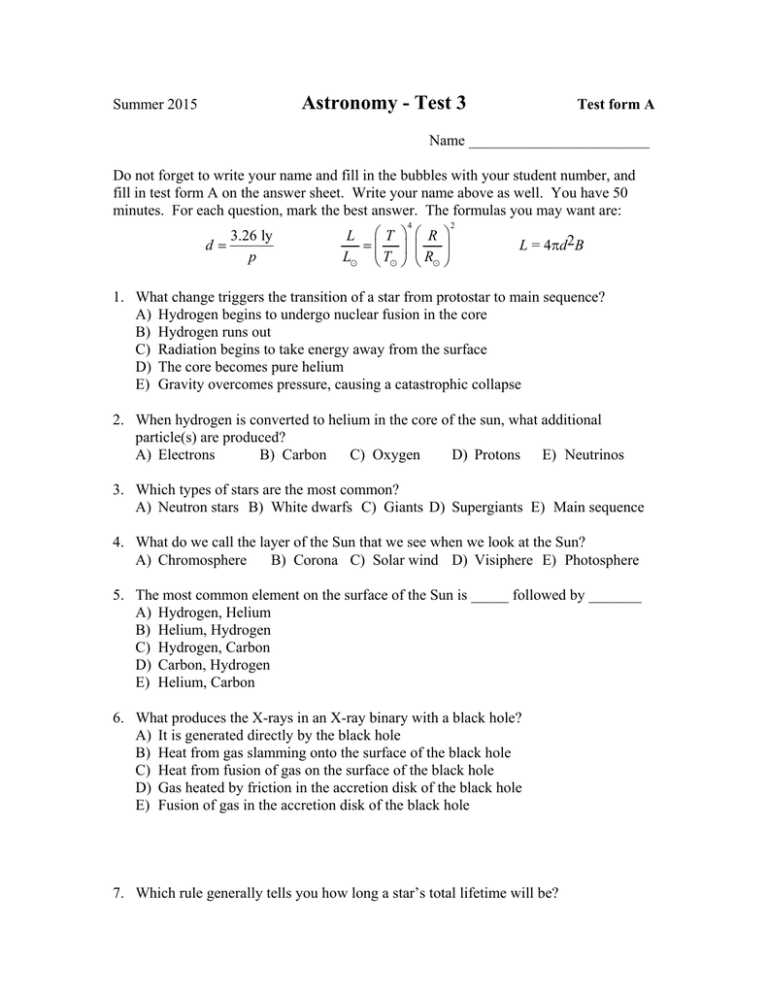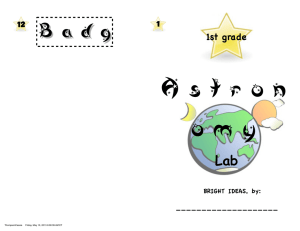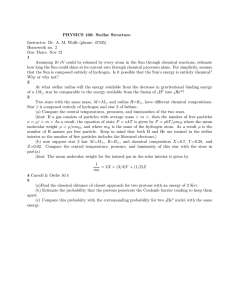Astronomy - Test 3
advertisement

Astronomy - Test 3 Summer 2015 Test form A Name ________________________ Do not forget to write your name and fill in the bubbles with your student number, and fill in test form A on the answer sheet. Write your name above as well. You have 50 minutes. For each question, mark the best answer. The formulas you may want are: 3.26 ly d p 4 L T R L T R 2 L = 4d2B 1. What change triggers the transition of a star from protostar to main sequence? A) Hydrogen begins to undergo nuclear fusion in the core B) Hydrogen runs out C) Radiation begins to take energy away from the surface D) The core becomes pure helium E) Gravity overcomes pressure, causing a catastrophic collapse 2. When hydrogen is converted to helium in the core of the sun, what additional particle(s) are produced? A) Electrons B) Carbon C) Oxygen D) Protons E) Neutrinos 3. Which types of stars are the most common? A) Neutron stars B) White dwarfs C) Giants D) Supergiants E) Main sequence 4. What do we call the layer of the Sun that we see when we look at the Sun? A) Chromosphere B) Corona C) Solar wind D) Visiphere E) Photosphere 5. The most common element on the surface of the Sun is _____ followed by _______ A) Hydrogen, Helium B) Helium, Hydrogen C) Hydrogen, Carbon D) Carbon, Hydrogen E) Helium, Carbon 6. What produces the X-rays in an X-ray binary with a black hole? A) It is generated directly by the black hole B) Heat from gas slamming onto the surface of the black hole C) Heat from fusion of gas on the surface of the black hole D) Gas heated by friction in the accretion disk of the black hole E) Fusion of gas in the accretion disk of the black hole 7. Which rule generally tells you how long a star’s total lifetime will be? A) B) C) D) E) The more mass, the longer it lives The more mass, the shorter it lives The higher fraction of hydrogen, the longer it lives The higher fraction of hydrogen, the shorter it lives The faster it spins, the longer it lives 8. During the red giant stage, what is happening at the core of the star? A) Hydrogen is burning to helium B) There is an inert core of helium, not burning C) Helium is burning to carbon and oxygen D) There is an inert core of carbon and oxygen, not burning E) None of the above 9. Suppose we are studying a star, and discover that its hydrogen spectral lines are shifted to slightly shorter wavelength than for the Sun. This probably indicates that the star is A) Hotter than the Sun B) Cooler than the Sun C) Moving towards us D) Moving away from us E) Contains a slightly heavier isotope of hydrogen 10. Suppose two stars are in a tight binary arrangement, and the first star becomes a giant star. Which of the following is likely to happen at this stage? A) Mass transfers from the giant star to the other (only) B) The system becomes a nova (only) C) The system becomes an X-ray binary (only) D) All of the above E) None of the above 11. For a sun-like star, which of the following stages is the shortest? A) Double shell burning B) Core helium burning C) Red giant D) Main sequence E) Actually, all of these stages are about the same length of time 12. Prominences are caused by hot plasma expelled from the Sun. This plasma tends to follow what path as it leaves the Sun? A) It flows in a straight line, since there are effectively no forces on it B) It flows in curves governed caused by the Sun’s gravity C) It flows in curves caused because they follow magnetic field lines D) It flows in curves caused by always moving perpendicular to magnetic field lines E) It flows on curves governed by the underlying convection inside the Sun 13. Which of the following is not a property that nuclear fusion shares with ordinary burning? A) B) C) D) E) It requires heat It produces energy It requires fuel It requires oxygen Actually, all of these are properties of nuclear fusion 14. If star A and star B are the same size, but star B is 10 times hotter than star A, how many times more luminous is star B than star A? A) 10 B) 100 C) 1,000 D) 10,000 E) 100,000 15. How does energy make its way from the center of the Sun to the surface? A) It flows by radiation near the center, and convection on the outside B) It flows by convection near the center, and radiation on the outside C) It flows by convection everywhere D) It flows by radiation everywhere E) It is carried by neutrinos 16. During the course of its lifetime, in addition to helium, what elements will the Sun make? A) Carbon, but not oxygen nor neon B) Oxygen, but not carbon nor neon C) Carbon and oxygen, but not neon D) Carbon, oxygen, and neon E) None of the above 17. Which of the following objects is believed to be held up by degeneracy pressure, the quantum mechanical process where particles of the same type don’t like to be compressed into a small space? A) Black holes (only) B) White dwarfs (only) C) Neutron stars (only) D) Neutron stars and white dwarfs, but not black holes E) Neutrons stars, white dwarfs, and black holes 18. Which method can be used to deduce the distance to nearby stars, such as Sirius? A) Bounce a radar signal off them and see how long it takes for it to return B) Measure how long a spacecraft takes to journey there C) Measure the apparent changing position of the star as viewed from Earth throughout the year D) Find its velocity via the Doppler shift, estimate its age, and multiply distance times velocity to get distance E) Find its velocity via the Doppler shift, then use Hubble’s law to get the distance 19. According to current theory, the only thing that can escape from inside the event horizon of a black hole is A) Light B) Matter C) Neutrinos D) Electrons E) Nothing 20. At right is a very qualitative Hertzsprung Russel diagram, with four stars marked on it. Which star would have the largest radius? A) A B) B C) C D) D E) Insufficient Info A B C D 21. Which layer of the Sun’s atmosphere has the highest temperature? A) Chromosphere B) Corona C) Solar wind D) Visiphere E) Photosphere 22. Elements like iron and silicon that exist within the Earth probably originally came from A) Supernovas B) Dying Sun-like stars producing planetary nebulas C) Hawking evaporation from black holes D) The big bang E) Amazon.com 23. If you had already measured the brightness of a star, what additional piece of information would be sufficient to tell you the luminosity? A) Temperature B) Mass C) Size D) Composition E) Distance 24. When stars are born, which kinds of stars are most common? A) Very high mass stars B) Very low mass stars C) Stars with intermediate mass, around the Sun’s mass D) All mass stars are about equally common E) I have no idea; please mark this one wrong 25. A typical spectrum like the Sun’s is what type of spectrum? A) A continuous spectrum with all wavelengths in it B) A dark line or absorption spectrum C) A bright line or emission spectrum D) A spectrum with only long wavelengths, or red spectrum E) A spectrum with only short wavelengths, or blue spectrum 26. Which of the following spectral classes is hottest? A) B2 B) B7 C) K1 D) K8 E) F5 27. What mass (in solar masses) of star would likely end up as a black hole? A) 0.1 MSun B) 1.0 MSun C) 3.0 MSun D) 10 MSun E) 60 MSun 28. When you look at the Sun, the edges appear slightly dimmer than the center. This effect is because A) Fusion takes place primarily near the center, so this is the hottest B) The high velocity of the equator makes it hotter and hence brighter C) There are more sunspots (which are cool) near the edges, making them look cooler D) Looking straight at the center, we can see farther into the Sun, to a deeper and hotter layer E) It is an illusion caused by the diffraction of the Earth’s atmosphere caused by the hot rays of the Sun 29. Electrical currents can flow in the Sun because A) It contains metals such as iron, which is a conductor B) Due to incredible pressure, the hydrogen in the Sun becomes a liquid metal C) The electrons actually stay tied to the atoms, but the rotation of the Sun moves them, effectively generating a current D) The Sun is so hot that the electrons become loose, making it a plasma, which can then conduct electricity E) The electric fields are so powerful that they strip away electrons in a phenomenon called “dielectric breakdown” 30. Which of the following could be used to deduce that one stellar cluster is older than another? A) Number of stars: young clusters have a lot, old ones have few B) Number of stars: young clusters have few, old ones have a lot C) Color of stars: young clusters have bright blue stars, old ones do not D) Color of stars: young clusters have bright red stars, old ones do not E) Composition: old clusters contain much more helium than young clusters 31. Which of the following is the approximate size of a white dwarf star? A) A city B) Earth C) Jupiter D) Sun E) Much bigger than the Sun 32. The Sun will end its life as a A) Neutron star B) Black hole C) White dwarf D) Protostar E) Nothing 33. When we take a picture of a planetary nebula, we see a large cloud of gas that is typically glowing. What is causing that glow? A) It is merely reflections of the light from the star itself, now obscured by gas and dust B) Chemical reactions among the elements in the cloud C) Radioactive decay of the elements in the planets that make up the planetary nebula D) Collisions between the expanding gas causes the gas to glow E) Ultraviolet light from the dying star at the center caused the atoms to gain energy, and when they lose it again they glow




